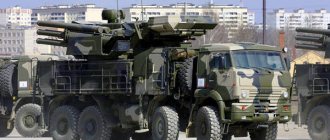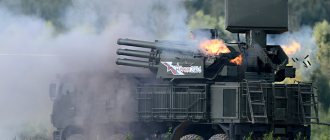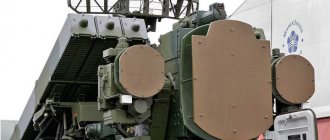Pantsir-S1, according to NATO codification – SA-22 Greyhound, according to the GRAU index – 96K6, is a ground-based self-propelled anti-aircraft missile and gun system manufactured in the Russian Federation.
The development was carried out at the state unitary enterprise Instrument Design Bureau. The functionality is to ensure the security of defended objects from surface and ground threats, as well as to provide short-range cover for military and civilian objects from promising and modern air attack weapons.
The creation of the air defense missile system dates back to 1994; it was demonstrated to the general public at the MAKS-1995 air show. Subsequently, Pantsir-S1 was modernized many times, the latest modification was presented at MAKS-2007. In November 2012, the complex was put into service.
Photos
Armament of the Pantsir S-1 complex
There are 12 ready-made missiles on board the Pantsir S-1 combat vehicle. The complex is four-channel, works on the target and on the missile. It can fire four missiles at intervals of one or one and a half seconds, and all of them will be aimed simultaneously at four targets. And this is another high quality of the complex, which in such dimensions can hardly be provided by anyone in the world in the near future.
In addition to missiles, the combat module includes anti-aircraft guns developed by Arkady Shipunov and Vasily Gryazev. The combat vehicle carries 1,500 ready rounds of ammunition, and these machine guns are effective against both ground and air targets.
The Pantsir S-1 complex hits any targets with anti-aircraft guns, including lightly armored and protected ones, at a distance of up to 4 km. If an air target appears within range, that is, at an altitude of approximately 3 km, it also effectively fires at them and is capable of providing cover for the defended object or the battery itself.
Review
Pantsir-S1 has a short range of action, is installed on a tracked or wheeled chassis of a trailer, truck, or is installed permanently. It is managed by three or two operators. Air defense is provided by radio-guided missiles with radar and infrared tracking, as well as automatic cannons. The air defense missile system has the ability to combat manpower and lightly armored ground targets.
In order to implement noise immunity, the communication system makes changes to the frequency of 3500 hops/s over a wide range according to a pseudo-random law. Due to the modular principle, the ZRPK can be installed on all chassis.
Purpose of the Pantsir-S1 air defense missile system
ZRPK "Pantsir-S1" is designed for air defense of small military and administrative-industrial facilities and areas from aircraft, helicopters, cruise missiles and precision weapons, guided bombs and remotely piloted vehicles, as well as to strengthen air defense groups when repelling massive air strikes and support defeating lightly armored targets.
Figure 2. ZRPK "Pantsir-S1"
Performance characteristics
4.1 Main characteristics
- Type: ZRPK
- Crew, hours: 3
- Complex weight, kg: up to 30,000 (proportional to chassis)
- Deployment time, min: 8-9
- Reaction time, s: 4-6
- Ammunition: 1400 shells, 12 57E6-E missiles.
4.2 Detection system characteristics
- Radar stations: 1RS2, 1RS1-1E
- Type of radar stations: three-coordinate dual-band
- Antenna type: phased array antenna
- View azimuth (tracking/detection): (0 to 82)/45 degrees, thanks to mechanical rotation - 360
- Viewing Angle (Tracking/Detection): (0 to 82)/45 degrees
- Range (RCS 2 m²) (tracking/detection): 36/30 km
- Optical-electronic tracking system: available
- Field of view: 1.8 x 2.7 degrees
- Modes: manual/automatic
- Range, m: 18000.
4.3 Missile weapons (57E6-E)
- Type: supersonic two-stage solid propellant
- Guidance: radio command
- Speed, m/s (average at a distance of 18 km/maximum): 700/1300
- Maximum target speed: 1000 m/s
- Range to target, m: 1200 - 20000
- Target altitude, m: 15 – 1500
- Length. cm: 320
- Caliber: 170/90 mm
- Weight (with/without TPK), kg: 94/74.5
- Warhead type: rod
- Warhead weight, kg: 20
- Mass of explosives warhead. kg: 5.5.
4.4 Cannon armament (2A38M)
- Type: anti-aircraft twin machine gun
- Caliber, mm: 30
- Effective maximum firing range, m: 4000
- Total rate of fire: 5000 rounds/min
- Barrel survivability: less than 8000 shots
- Type of ammunition: armor-piercing incendiary
- Initial bullet speed, m/s: 960
- Cartridge weight, g: 842
- Projectile mass, g: 389.
"Pantsir-S1M" against attack drones
ZRPK "Pantsir-S1M". Photo by Rosoboronexport
Modern reconnaissance and strike unmanned aerial vehicles capable of carrying guided weapons pose a significant danger to ground forces. To combat such threats, anti-aircraft weapons with high performance and special capabilities are required. The other day it was announced that the modernized Pantsir-S1M missile and gun system will be able to provide protection against attack UAVs.
Last news
The international military-technical exhibition EDEX-2021 is currently taking place in Cairo.
Russian industry is represented at this event by a number of organizations, incl. the High Precision Complexes holding and its parent state corporation Rostec. A number of modern weapons and equipment are demonstrated in the form of full-scale samples and mock-ups, incl. updated air defense missile system "Pantsir-S1M". As TASS reports, during the Egyptian exhibition, Deputy General Director of High-Precision Complexes Sergei Mikhailov raised the topic of protection against UAVs and revealed the prospects of the modernized Pantsir in this context. The head recalled that countering drones is one of the main tasks for air defense. He also pointed out that our country is currently producing two classes of anti-UAV weapons. These are soft-kill systems that use the principles of electronic suppression, and hard-kill anti-aircraft systems that destroy the target. A representative of the second class is the Pantsir-S1M air defense missile system.
"Pantsir-SM" for the Russian army. Photo "Rostec"
Earlier this year, at the IDEX-2021 exhibition, Russian industry drafted a control network combining systems of both classes. The modernized Pantsir-S1M air defense missile system should enter such a network and become one of its main components.
S. Mikhailov also said that Pantsir-S1M is highly economically efficient. When fighting against UAVs, it shows the necessary combat qualities, and the cost of spent ammunition remains at an acceptable level. In general, such an air defense missile system is the least expensive anti-drone weapon available on the market to operate.
Industrial director of the arms cluster of the Rostec state corporation Bekhan Ozdoev supplemented S. Mikhailov’s statements. He noted that as a result of the modernization, the characteristics of the Pantsir-S1M complex for combating UAVs have increased significantly. In particular, it can now detect and destroy all types of attack drones currently in service with different countries.
Features of modernization
According to known data, the Pantsir-S1M product is an export version of the Pantsir-SM air defense missile system, developed for the Russian armed forces. Both projects provide for the replacement of some radio engineering and other equipment, and also offer an anti-aircraft missile with improved characteristics. At the same time, the capabilities of the export "Pantsir" are limited in comparison with the basic version of the "SM".
The DJI Phantom commercial UAV is one of the most popular models, incl. for military use. Photo: Wikimedia Commons
Like the complexes of previous modifications, the new Pantsirs can be mounted on different chassis or used in a container design. The layout with a rotating combat module on which radar equipment and all weapons are located has been retained.
It was previously reported that the latest modernized versions of missile and gun systems receive new radar equipment. The improved radar is capable of detecting and tracking targets at ranges of up to 75 km, depending on their parameters. Optical-electronic means for observing and tracking targets in the near zone have been retained. Other elements of the electronic complex have been modernized with an increase in all basic characteristics. Increased performance, improved noise immunity, etc.
In addition to the existing anti-aircraft guided missile, a new one has been created. The firing range of the new missile defense system has been increased from 20 to 30 km, and the strike height has been increased from 15 to 18 km. Due to the increase in flight characteristics, the volume of the affected area is tripled. Radio command guidance is maintained, due to which the shooting accuracy is determined by the improved characteristics of the air defense missile system onboard equipment.
Another ammunition has been developed for the Pantsir-SM complex. This is a lightweight missile defense system of reduced dimensions with reduced power and limited flight characteristics. Such a missile is intended to combat small-sized targets for which the standard Pantsir missile defense systems are technically and economically redundant. Light missiles in transport and launch containers are placed on a quad installation. The latter corresponds in diameter to the TPK of the main missiles, but is noticeably shorter.
Heavy attack UAV Bayraktar Akıncı is a threat of the near future. Photo by Baykar Savunma
The artillery unit on the Pantsir-S1M/SM remains the same. Hitting targets at ranges up to 3-4 km and altitudes up to 2-3 km is ensured by a pair of double-barreled 30-mm 2A38M assault rifles. Ammunition - 1400 shells of various types.
Interception tasks
Intercepting an unmanned aerial vehicle is a rather complex task, and its solution faces various difficulties at almost all stages.
Thus, a small plastic UAV is difficult to detect and track; it is no less difficult to aim weapons at it. At the same time, the missile defense system, designed to destroy full-size air targets, may be redundant in terms of characteristics and cost for an intercepted drone. In the case of the latest versions of the Pantsir air defense missile system, the task of detecting the entire range of air targets, from aircraft to light UAVs, is solved using modern radars with high performance, created incl. for such work. Objects with low RCS are detected and tracked by optical means. While inferior to radar in detection range, optics demonstrate the necessary accuracy and reliability of capture.
It should be noted that medium and heavy UAVs capable of carrying strike weapons are large in size and have corresponding radar visibility. Accordingly, Pantsir-SM/S1M or another modern anti-aircraft system will be able to timely detect such a threat and respond to it.
Parade crew of "Shells". In the foreground is the latest version of the SM, equipped with new light missiles. Photo by the Russian Ministry of Defense
“Shells” of all modifications, including the latest “SM” and “S1M”, can operate independently and as part of a layered air defense system. In the latter case, the air defense missile system can take on the role of a fire weapon, and transfer detection tasks to other systems that have technical or other advantages.
The composition of a multicomponent defense system with separate radars, missile-gun and other complexes, electronic warfare equipment, etc. can be determined in accordance with the current conditions and characteristics of the covered area. The High Precision Complexes believe that Pantsir-S1M is quite capable of becoming the leading element of such a system.
The creation of a new missile defense system with increased range and altitude provides an obvious increase in combat qualities. In addition, improved radio equipment has a positive effect on such characteristics. In the near zone, missiles are complemented by cannons with fairly high accuracy and power. Pantsir-SM also receives an additional light missile designed to hit complex small targets. However, as far as we know, it is not yet included in the export kit of the Pantsir-S1M.
Market sample
Attention should be paid to the fact that statements about the new capabilities of the modernized air defense missile system were made at a foreign military-technical exhibition. At the same time, we were talking about the export modification of the Pantsir-S1M. All this shows that our industry continues to promote its new development on the international market and is looking for customers. To attract future buyers, the heads of High-Precision Complexes and Rostec are revealing all the most interesting facts about the Pantsir in its new version.
"Pantsiri-SM" on Red Square, 2022. Photo of the Russian Ministry of Defense
It is very likely that such “advertising” will be useful and will influence the decisions of potential buyers. Many countries are concerned about the development and proliferation of UAVs, and recent conflicts show the validity of this response. At the same time, Russia is ready to offer modern air defense systems capable of coping with both “traditional” means of air attack and the new unmanned threat.
It must be recalled that the Pantsir-S1M has ceased to be exclusively an exhibition model. In August of this year, at the Army-2021 forum, the first contract was signed for the supply of such equipment to an unnamed foreign customer. In addition, we should not forget previous orders for early versions of Pantsir.
All this shows that the latest Russian anti-aircraft missile and gun systems are of real interest to foreign customers. At the same time, the achieved growth in characteristics and the emergence of new opportunities should attract additional attention. And it is quite possible that, following recent statements and the results of the EDEX-2021 exhibition, new contracts will appear for the export version of the Pantsir.
Modifications of Pantsir-S
Novel - 1994. The prototype is made on the Ural-5323-20 chassis.
ZPRK 96K6 - 2005. Serial version, made on the KamAZ-6560 chassis.
Pantsir-S1-O - 2005. Armament: 2x2 30mm 2A72, 2x4 57E6E. With an optical weapon control system (with a single-purpose channel). There is no tracking radar.
Pantsir-S1E is a modification for export purposes, made on the MAN-SX45 chassis. Foreign-made equipment was used. SAM - 9M311;
Pantsir-2E - 2006 - a special model for export purposes. Tracking radar with improved parameters;
Pantsir-S1 - 2006. Armament: 2x2 30-mm 2A38M, 2x6 57E6E. With a tracking radar with a 4-target channel, the target acquisition zone is 0.2-20 km in range and 0-15 km in altitude.
Pantsir-S1 (BM 72V6E) - Modification of the complex, made on the BAZ-6909-019 chassis.
Pantsir-S2 is a modernized complex for the Russian Armed Forces, in service.
Pantsir-M is a naval version of the Pantsir-S air defense missile system. It was planned to begin mass production from July 2015. In August 2015, an order was placed for the first three complexes, and on April 30, 2022, the first MRK of Project 22800, equipped with the complex, was launched.
Pantsir-ME - 2015. Armament: 8 ready missiles + 32 in reserve, 2x6 30 mm cannons. Offered for export. The complex should replace Dirk and some ships will be modified for it.
Pantsir-SA is an Arctic modification based on the DT-30 two-link tracked transporter. It was first presented to the general public at the Victory Parade on Red Square on May 9, 2022. Unlike the base model, there is no anti-aircraft gun, the number of missiles has been increased from 12 to 18, and the target detection station has been modernized.
Pantsir-SM is a modification in which, through the use of a newly developed multifunctional aiming station, the target engagement range is increased to 40 km, and the detection range is 75 km.
ZRPK "Pantsir-S1" based on KamAZ-6560











